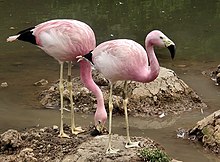Reserva Nacional del Titicaca
The Reserva Nacional del Titicaca is the Peruvian protected area of national rank on Lake Titicaca and comprises a quarter of the highest navigable lake in the world. Located in the Puno department , the reserve combines a huge biodiversity with unique cultural treasures that are representative of all of Peru .
The reserve was proclaimed on October 31, 1978 under Law 185-78-AA and, according to state data, covers 36,180 hectares of the lake area off Puno . The area is divided into two sectors: the much larger part (21,150 ha) is in the Puno sector . A smaller part (7013 ha) is in the Ramis sector . The administration of the area is the responsibility of the Peruvian National Park Agency Servicio Nacional de Areas Naturales Protegidas por el Estado (SERNANP) , which belongs to the Peruvian Ministry of the Environment. The area is designated as a resource protection area of IUCN Category VI .
The aim of the park is to protect the natural resources of the ecosystem of Lake Titicaca and the surrounding highlands. The reed grass ("tortora") , which can grow up to 4 m high, is of particular importance for life on the lake. Since it offers a retreat and rearing space for many of the lake's freshwater fish, birds build their nests in it and the locals use it in a variety of ways (building materials for houses and rafts, medicine, fodder), the preservation of the large reed areas is one of the primary goals of the reserve.
A number of threatened and partly endemic species live in the protected area , including over 87 bird, 26 fish and 9 amphibian species. Above all, endemic bird species can be found at the lake, including flamingos , various species of seagulls and hummingbirds . Notable representatives of the lake's flora are various aquatic plants, including various types of reed such as totora .
flora
The following plants are characteristic of the protected area
- Pond rushes ( Schoenoplectus ). Mainly Totora reeds ( Schoenoplectus californicus ).
- The little researched turf rush Trichophorum rigidum (Steud.) Goetgh., Muasya & DA Simpson (synonymous with Scirpus rigidus , span. Totorilla)
- Myriophyllum quitense (Spanish: fenouil llachu). This plant is used for biomonitoring in Argentina, as it can be used to read the stress in aquatic systems.
fauna

The bird life includes 13 families on some occurring types are:
- Chile teal ( Anas flavirostris )
- Black-tailed Duck ( Anas georgica )
- Versicolor duck ( Anas puna )
- Great Egret ( Ardea alba )
- Puna plover ( Charadrius alticola )
- Andean goose ( Chloephaga melanoptera )
- Andean gull ( Chroicocephalus serranus )
- Andean coot ( Fulica ardesiaca )
- Giant coot ( Fulica gigantea )
- Common pond rail ( Gallinula chloropus )
- Andean tern ( Haplochelidon andecola )
- Andean spur tyrant ( Lessonia oreas )
- Night heron ( Nycticorax nycticorax )
- Black-headed oar duck ( Oxyura ferrugínea )
- Olive shag ( Phalacrocorax brasilianus )
- Bins panties ( Phleocryptes melanops )
- Andean flamingo ( Phoenicoparrus andinus )
- Chilean flamingo ( Phoenicopterus chilensis )
- Punaibis ( Plegadis ridgwayi )
- Inca diver ( Podiceps occipitalis )
- Andean avocet ( Recurvirostra andina )
- Titicaca diver ( Rollandia microptera )
- Rollandtaucher ( Rollandia rolland )
Danger
The ecosystem in Lake Titicaca is endangered by various anthropogenic influences. The residents of the lake use its water as drinking water. In the last few decades, however, the water quality of the lake has continuously decreased. Above all, there is a lack of effective implementation of technical environmental protection. A cement factory 35 km from Puno is allowed to continue operating at night after its privatization. According to reports from local biologists, this often creates a large cloud of lime dust that pulls across the lake with the north wind. The lime falls over the lake and the reserve.
The catch basins of the sewage treatment plant in Puno are only separated from the lake by an earth wall. In the rainy season , unexplained faeces regularly find their way into the lake, which leads to strong eutrophication and thus algae formation.
tourism
From the pier in Puno there are regular trips to the reed areas of the protected area. A small environmental education tent is also operated at the port in the summer months.
literature
- Guía Turística del Departamento de Puno Tourist guide of the Puno department (Spanish)
- INRENA: Flora y Fauna Silvestre , 1997
Web links
- Protected area Titicaca at the protected area agency SERNANP (Spanish)
- Protected area blogspot (Spanish)
Individual evidence
- ↑ The Plant List [1] ; the accepted name: [2]
- ↑ Stefan Siehl: Problems of sustainable tourism on Lake Titicaca in Perú - using the example of Isla de Taquile and Península de Capachica . Books on Demand GmbH, 2005, ISBN 978-3-638-88280-4 , pp. 57 ( full text in Google Book Search [accessed April 10, 2010]).
Coordinates: 15 ° 50 ′ 11 ″ S , 69 ° 20 ′ 19 ″ W

